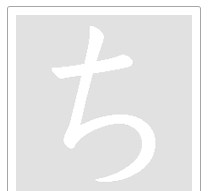 |
||||
 |
||||
Hiragana-2 |
||||||||||||
|
The first character こ is ご without two dots. For the rest of the characters, follow the stroke order as the video shows and practice how to write them. |
||||||||||||
| ん n
This is how to draw the character ん. It is composed of a single stroke.
ん represents the hiragana equivalent to ン in katakana. To get ん on a computer, either type n and the conversion key, or type nn. |
|
|||||||||||
| に ni
This is how to draw the character に. It is composed of three strokes.
に represents ni, so it is equivalent to ニ in katakana.
|
|
|||||||||||
| ち chi
This is how to draw the character ち. It is composed of two strokes.
ち represents chi, equivalent to チ in katakana. Whether you spell chi or ti, the computer will give you ち. By clicking for its sound, try to learn how to correctly pronounce ち. Notice it is neither [chi] nor [ti] in English. |
|
|||||||||||
| わ wa
This is how to draw the character わ. It is composed of two strokes.
While は basically represents ha as learned in the previous section, when it is used as a phrase-particle (See Lesson 17 of SUN, Step Up Nihongo), it is pronounced as wa. Although konnichiwa is taken as an independent greeting, konnnichi stands for "this day" and wa is a phrase-particle meaning "as for"; therefore, it literally means "as for today" implying what is to follow, i.e. "how are you?" "are you fine?" etc. which is unsaid. For this reason, wa in konnnichiwa has traditionally been written in は. Recently, however, わ which represents wa like ワ in katakana is gradually taking its place. So, whether written as こんにちは or こんにちわ, it is read as konnichiwa. Now,
write こんにちは
and こんにちわ
in window
below. |
|
|||||||||||
|
Try to read こんばんは and こんばんわ on your own. There is no completely unfamiliar character here. While konnichi means "this day", komban stands for "this evening" and は is the same phrase-particle meaning "as for". Hence, kombanwa literally translates "as for this evening" implying "how are you?" "are you fine?" etc. For the same reason discussed above, wa is traditionally written with は but recently わ is gradually taking it over. Write こんばんは
and こんばんわ
in window
below. |
||||||||||||

|
||||||||||||





